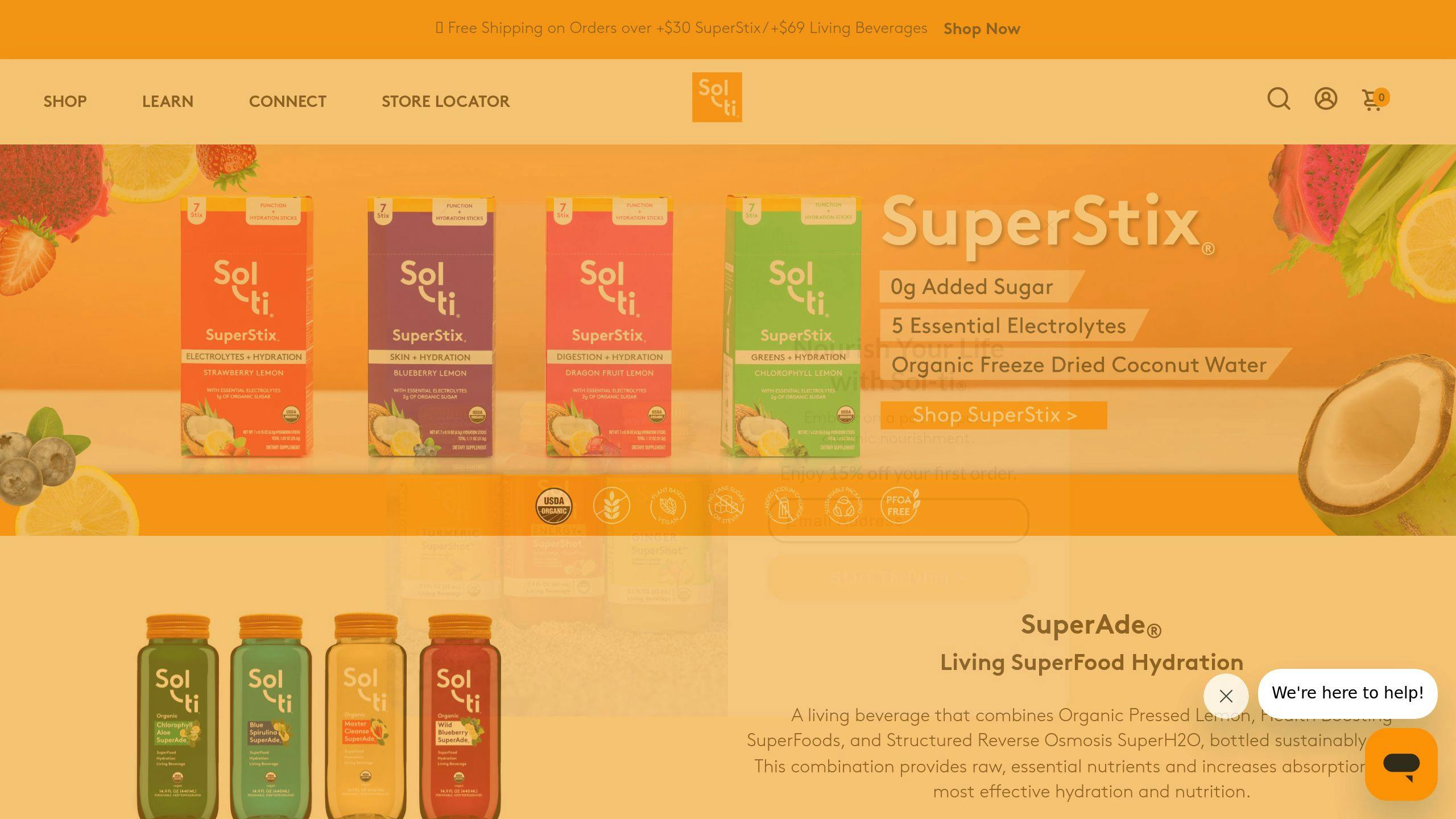Your drink choices impact the planet. The carbon footprint of beverages comes from every stage - ingredients, production, packaging, transport, and disposal. Here's what you need to know:
- Packaging matters most: Glass bottles produce 95% more emissions than aluminum cans. Plastic, while less recyclable, is up to 80% more efficient to produce.
- Consumer behavior drives change: 42% of buyers now consider environmental impact, and carbon labels can reduce emissions by 9.2%.
- Industry solutions are emerging: Innovations like paper bottles cut emissions by 90%, and brands are shifting to lighter, recyclable, and plant-based materials.
Key takeaway: Small choices - like opting for sustainable packaging - add up, reducing emissions and pushing the beverage industry toward greener practices.
What Contributes to the Carbon Footprint of Beverages
Main Sources of Carbon Emissions in Beverage Production
The carbon footprint of beverages comes from several stages in their lifecycle. From growing and processing ingredients like sugar, coffee, and tea to energy-heavy manufacturing processes, each step adds to emissions. Key contributors include raw material extraction, production methods, packaging, and transportation.
Among these, packaging plays a major role and offers one of the best opportunities for reducing emissions.
How Packaging Impacts Carbon Emissions
Packaging choices can greatly affect a beverage's carbon footprint. For example, while producing glass requires significant energy, plastic can be more efficient in terms of production yield. Research shows plastic packaging can be up to 80% more efficient per kilogram produced [2][5].
New materials, like Pulpex's paper bottles, show promise by cutting emissions by 90% compared to glass. These developments highlight the importance of consumer support in pushing for better packaging solutions.
The Role of Consumer Awareness in Driving Change
Consumer demand plays a huge role in shaping the industry. Since 2022, there’s been an 18-percentage-point rise in environmentally conscious purchasing [1]. Tools like carbon footprint labels, which use color codes or monetary values, help consumers make greener choices [3].
More than half of consumers believe manufacturers are responsible for leading environmental improvements [1]. This growing pressure has pushed companies to adopt greener practices and improve transparency, which directly impacts industry standards and helps lower emissions.
How Packaging Choices Influence Carbon Emissions
Comparing the Carbon Footprint of Glass, Plastic, and Other Materials
The impact of beverage packaging on carbon emissions varies greatly depending on the material used. Studies indicate that glass bottles contribute about 95% more to global warming compared to aluminum cans [4].
| Material Type | Production Impact | Transportation Impact | Recyclability | Total CO2e (per jar) |
|---|---|---|---|---|
| Glass | Very High | High | Unlimited | 246.6g |
| Plastic | Moderate | Low | Limited cycles | 49.4g |
| Aluminum | High | Low | High efficiency | Moderate |
For instance, producing 1 million 2-ounce glass jars results in 246.6 metric tons of CO2, whereas the same number of plastic jars generates only 49.4 metric tons [2]. The weight difference is also striking: a one-liter glass bottle weighs roughly 800g, while a comparable plastic bottle weighs just 40g [4].
Despite its higher carbon footprint, companies like Sol-ti continue to use glass due to its perceived benefits for health and product quality.
Case Study: Sol-ti's Use of Glass Bottles

Sol-ti provides an example of how businesses navigate the environmental trade-offs of packaging. Their choice to use glass bottles reflects both consumer preferences and branding strategies. Glass is often seen as a high-quality, eco-conscious material, which influences decisions even when its carbon impact is higher.
Key advantages of glass include:
- Non-toxic composition
- Ability to be recycled infinitely without losing quality
- Better preservation of product integrity
Ultimately, consumer demand for materials like glass plays a significant role in shaping packaging strategies.
How Consumer Demand for Better Packaging Can Make a Difference
Recent research shows that 42% of consumers actively consider environmental factors when making purchases [1]. This shift has pushed companies to rethink packaging.
"Consumers expect food companies to take action", says Moritz Breuninger, a principal at Kearney's consumer practice [1].
In response, beverage companies are:
- Adopting lighter and recycled materials
- Developing new sustainable packaging options
These efforts highlight how consumer choices can drive meaningful changes in packaging practices and help reduce carbon emissions on a larger scale.
sbb-itb-74fe2fe
Ways to Lower the Carbon Footprint of Beverages
Packaging Innovations to Cut Emissions
The beverage industry, responsible for 3.8% of global emissions, is turning to new packaging solutions to tackle its environmental impact [6]. Alternatives like plant-based plastics and compostable materials are becoming more popular, offering a way to replace traditional packaging [2][4].
On top of that, technologies such as carbon capture are being integrated into production processes to minimize emissions without compromising product quality. When paired with consumer education, these advancements can encourage broader adoption of environmentally friendly practices.
Empowering Consumers to Choose Greener Options
Labels, monetary displays, and color-coded systems that highlight carbon footprints are giving consumers the tools to make more informed choices. These methods make it easier for shoppers to understand the environmental impact of their purchases, guiding them toward more sustainable options [3].
Beyond packaging, carbon capture is also tackling emissions from production processes. While individual decisions play a role, coordinated efforts across the industry can create a much larger impact.
Industry Collaborations to Reduce Emissions
Partnerships within the beverage industry are paving the way for impactful emission reduction strategies. Companies are focusing on initiatives like:
- Using solar and wind energy in manufacturing facilities
- Creating shared recycling systems and setting sustainability benchmarks
Cleaner methods for CO2 production in beverages are becoming standard [6], driven by regulations pushing the industry toward net-zero emissions by 2050 [6]. Brands like Sol-ti are leading by example, blending eco-friendly packaging with consumer education to promote environmental responsibility.
Battle Of The Bottles: Plastic Vs Glass Vs Aluminum
Conclusion: Small Choices Can Lead to Big Changes
The choices we make as consumers have a direct impact on the beverage industry's carbon footprint, shaping everything from how products are packaged to how they’re made. This evolving behavior is pushing the industry to rethink its practices.
Take packaging, for example. Glass may produce more greenhouse gases during production compared to plastic, but it offers perks like being endlessly recyclable and non-toxic. Companies like Sol-ti are proving that combining smart packaging choices with organic ingredients can create a well-rounded approach to responsibility.
Consumer demand is also pushing brands to step up their game. Tools like color-coded carbon footprint labels have nudged buyers toward greener options, cutting emissions by 4.3% [3]. As people continue to prioritize eco-friendly choices, companies are responding with solutions like plant-based plastics and recyclable materials - showing how informed decisions can lead to real progress.
This shift, often called "climavorism" [1], highlights a growing focus on environmentally conscious habits. By choosing sustainable packaging and supporting brands with eco-friendly practices, consumers are playing a key role in driving change. These everyday decisions, though small, add up to a bigger impact, helping pave the way for a more sustainable beverage industry. Individual actions can and do make a difference.


